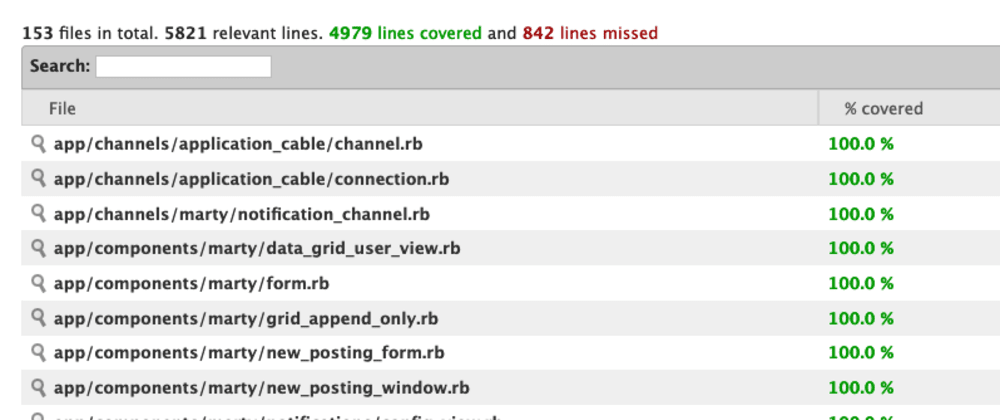EDIT (10/04/2020): Edited to reflect slightly cleaner practices, and use
the collate method in SimpleCov that does a lot of work for you.
simplecov is a useful code coverage tool built for Ruby projects. It encapsulates Ruby's own Coverage API and is, by far, the most popular gem and library for code-coverage.
 simplecov-ruby
/
simplecov
simplecov-ruby
/
simplecov
Code coverage for Ruby with a powerful configuration library and automatic merging of coverage across test suites
SimpleCov 



Code coverage for Ruby
SimpleCov is a code coverage analysis tool for Ruby. It uses Ruby's built-in Coverage library to gather code coverage data, but makes processing its results much easier by providing a clean API to filter, group, merge, format and display those results, giving you a complete code coverage suite that can be set up with just a couple lines of code SimpleCov/Coverage track covered ruby code, gathering coverage for common templating solutions like erb, slim and haml is not supported.
In most cases, you'll want overall coverage results for your projects, including all types of tests, Cucumber features etc. SimpleCov automatically takes care of this by caching and merging results when generating reports, so your report actually includes coverage across your test suites and thereby gives you a better picture of blank spots.
The official formatter of SimpleCov…
I spent a good chunk of this past weekend trying to integrate SimpleCov into a framework called Marty that we work on at my company, PennyMac Loan Services.
We use GitLab CI at PennyMac for continuous development workflows, and while it's a fantastic piece of software, getting it to work with a code coverage tool like SimpleCov is not quite a "batteries included" situation.
While SimpleCov does support merging coverage reports from different test libraries and suites, I ran into some difficulties getting it to merge results from multiple different runs using subsets of the same test suite. This is particularly important for our use case since we parallelize our test suite during CI pipeline runs by category, and we'd like to get an overarching coverage report for the whole suite instead of just the coverage of individual categories.
This post assumes that you already know what SimpleCov is and have it integrated into a Ruby project, but want to learn how to use it effectively with GitLab CI to get the most out of it. Unfortunately, it won't cover deploying coverage reports to GitLab pages, as there is already a fantastic article (which has inspired large parts of this post) on the matter. Enjoy!
Quick setup details
The most basic way to get started with SimpleCov is to add the Gem to your bundle, and then put something like this at the beginning of your spec_helper.rb, or whatever conventional pre-test file you load before running your suite:
# spec/spec_helper.rb
require 'simplecov'
SimpleCov.start
ENV['RAILS_ENV'] ||= 'test'
ENV['TZ'] ||= 'America/Los_Angeles'
This is fine, although if you need to do any more configuration than this
(which we will need for this scenario), I recommend having a helper file for
SimpleCov. I put mine in lib/ so I could reuse it in different applications:
# lib/marty/simplecov_helper.rb
# Credit goes to https://gitlab.com/gitlab-org/gitlab-foss/blob/master/spec/simplecov_env.rb
require 'simplecov'
require 'active_support/core_ext/numeric/time'
module SimpleCovHelper
def self.configure_profile
SimpleCov.configure do
enable_coverage ENV.fetch('COVERAGE_METHOD', 'line').to_sym
track_files '{app,config,lib,spec}/**/*.rb'
add_filter 'db/migrate'
add_filter 'vendor/'
add_filter 'extjs/'
add_group 'Channels', 'app/channels'
add_group 'Netzke Components', 'app/components'
add_group 'Controllers', 'app/controllers'
add_group 'Helpers', 'app/helpers'
add_group 'Jobs', ['app/jobs', 'app/workers']
add_group 'Mailers', 'app/mailers'
add_group 'Models', 'app/models'
add_group 'Services', 'app/services'
add_group 'Configs', 'config/'
add_group 'Libraries', 'lib/'
add_group 'Specs', 'spec/'
use_merging true
merge_timeout 1.day
end
end
def self.start!
return unless ENV['COVERAGE'] == 'true'
configure_profile
SimpleCov.start
end
end
A quick explanation of what's going on here:
- We expose the
SimpleCov.startfunction viastartin the module. That allows us to add more options before actually starting coverage tracking. - We only run coverage if the
COVERAGEenvironment variable is set. Coverage generation is potentially an expensive operation and can make RSpec suite runs take much longer, so it should be an opt-in feature.
We also call the configure_profile method, which defines some basic but
helpful configuration variables.
SimpleCov usually recommends using the rails profile when calling start.
This works for most people; however, it suppresses coverage for the config/
and spec/ directories, which I wanted. So I chose instead to build a similiar
configuration to the rails profile, but leaving in coverage for config/
and spec/:
# lib/marty/simplecov_profile.rb
require 'simplecov'
require 'active_support/core_ext/numeric/time'
SimpleCov.profiles.define :marty do
enable_coverage ENV.fetch('COVERAGE_METHOD', 'line').to_sym
track_files '{app,config,lib,spec}/**/*.rb'
add_filter 'db/migrate'
add_filter 'vendor/'
add_filter 'extjs/'
add_group 'Channels', 'app/channels'
add_group 'Netzke Components', 'app/components'
add_group 'Controllers', 'app/controllers'
add_group 'Helpers', 'app/helpers'
add_group 'Jobs', ['app/jobs', 'app/workers']
add_group 'Mailers', 'app/mailers'
add_group 'Models', 'app/models'
add_group 'Services', 'app/services'
add_group 'Configs', 'config/'
add_group 'Libraries', 'lib/'
add_group 'Specs', 'spec/'
use_merging true
merge_timeout 1.day
end
This allows me to reuse this profile in multiple applications with little hassle.
It also makes my SimpleCovHelper module look something like this:
# spec/support/simplecov_helper.rb
require 'marty/simplecov_helper'
module SimpleCovHelper
def self.start!
return unless ENV['COVERAGE'] == 'true'
SimpleCov.start :marty
end
end
I also like to pre-require my SimpleCov Helper using RSpec's dotfile: .rspec:
--require marty/simplecov_helper
--require spec_helper
This requires marty/simplecov_helper and then spec_helper in that order,
allowing me to just throw this at the very beginning of spec_helper:
# spec/spec_helper.rb
Marty::SimpleCovHelper.start!
ENV['RAILS_ENV'] ||= 'test'
ENV['TZ'] ||= 'America/Los_Angeles'
Getting Coverage in GitLab CI
If you enable coverage and run any RSpec test (a single file or a whole suite), you'll get something like this:
$ COVERAGE=true bundle exec rspec
.................................
Finished in 1 minute 15.14 seconds (files took 1.73 seconds to load)
249 examples, 0 failures, 8 pending
Coverage report generated for RSpec to #{Rails.root}/coverage. 1170 / 1230 LOC (95.12%) covered.
See that last part down there? The one that says 1170 / 1230 LOC? That's the results of the test coverage report, and it's exactly what we're looking to parse. Specifically, the percentage.
GitLab CI's configuration will live in a .gitlab-ci.yml file in the root of your project, and there is a great detail of rigorous configuration that can go into it. What we specifically care about here is your job that runs your RSpec test. Here is a rudimentary example of such job:
# .gitlab-ci.yml
image: ruby:2.6.3-buster
before_script:
- gem install bundler
- bundle install --jobs $(nproc) --path vendor "${FLAGS[@]}"
rspec:
stage: test
script:
- bundle exec rspec
After enabling coverage via variables, we will need to extract it from the output of the job, and this is exactly what the coverage key is for!
The coverage key takes a regular expression that matches the output percentage of your job, and embeds it into the results that we saw in the above screenshot:
# .gitlab-ci.yml
rspec:
stage: test
coverage: '/LOC\s\(\d+\.\d+%\)\scovered/'
variables:
COVERAGE: "true"
script:
- bundle exec rspec
This is most likely not the simplest regular expression to match "LOC (xx.xx%) covered", but it's working fine for me so far, so feel free to use it.
GitLab CI will now pick up parse the output of the job looking for a string matching that regex, and when it finds it, it'll display it in your Merge Request page and job results!
Viewing Artifacts
Since you may want to view your coverage reports generated by CI in the future, I suggest releasing the reports as job artifacts so they can be cached and downloaded later for review:
# .gitlab-ci.yml
rspec:
stage: test
coverage: '/LOC\s\(\d+\.\d+%\)\scovered/'
variables:
COVERAGE: "true"
script:
- bundle exec rspec
artifacts:
paths:
- "coverage/"
name: "Pipeline $CI_PIPELINE_ID Coverage Report"
This'll generate an artifact with a unique, descriptive name for each pipeline that runs, including the pipeline's ID (viewable through your MR or the Pipelines section in CI/CD).
Multiple/Parallelized Test Suite
Things get much more interesting if you decide to parallelize your test suite; this means you don't run all of your specs in one go, but instead in different CI jobs. This is fine, but it makes getting complete suite coverage much more difficult.
To solve for this use case, we'll have to find a way to combine all of our results in one place and merge them (and fortunately, SimpleCov already has us covered on that front).
Getting all your coverage results together
Suppose that your .gitlab-ci.yml looks something like the above examples, except that you've decided to use a base job to split off your rather massive test suite into multiple categories:
# .gitlab-ci.yml
.base-rspec:
stage: test
coverage: '/LOC\s\(\d+\.\d+%\)\scovered/'
image: ruby:2.6.3-buster
before_script:
- gem install bundler
- bundle install --jobs $(nproc) --path vendor "${FLAGS[@]}"
variables:
COVERAGE: "true"
rspec-models:
extends: .base-rspec
script:
- bundle exec rspec spec/models
rspec-controllers:
extends: .base-rspec
script:
- bundle exec rspec spec/controllers
rspec-lib:
extends: .base-rspec
script:
- bundle exec rspec spec/lib
rspec-features:
extends: .base-rspec
script:
- bundle exec rspec spec/features
Each one of these guys will generate its own unique coverage report, but they won't be complete.
Most likely, one category of tests does not span all your project's files and as such will result in odd, incomplete reports of 51.43% or even 37.22% coverage.
What we actually want is the product of all of our divided test suites together, and this has to be done by combining them in a single job, and then generating the report.
To do that, create a new stage in your pipeline stages called codecov:
# .gitlab-ci.yml
stages:
- build
- test
- codecov
- deploy
You could also use the default deploy stage, but it has to be any stage that comes after test.
To combine all the reports, we're going to want them to have unique names when they all end up together in the code coverage job, so one doesn't overwrite the other. SimpleCov has a mechanism to give jobs unique names, and we can do this based on environment variables.
Add this to the SimpleCov Profile that we created:
# lib/marty/simplecov_helper.rb
SimpleCov.profiles.define :marty do
# ...
if ENV['GITLAB_CI']
job_name = ENV['CI_JOB_NAME']
coverage_dir "coverage/#{job_name}"
command_name job_name
SimpleCov.at_exit { SimpleCov.result }
end
So now, if the job is titled rspec-features, SimpleCov will spit out the results in a folder called coverage/rspec-features" in the root.
Next, we want to make sure we pass on our individual, uniquely named coverage reports to the job that will combine them, and we will do this using artifacts. Take our .base-rspec job and add the following artifacts field to it:
# .gitlab-ci.yml
.base-rspec:
stage: test
coverage: '/LOC\s\(\d+\.\d+%\)\scovered/'
image: ruby:2.6.3-buster
before_script:
- gem install bundler
- bundle install --jobs $(nproc) --path vendor "${FLAGS[@]}"
variables:
COVERAGE: "true"
artifacts:
paths:
- "coverage/$CI_JOB_NAME" # look for the unique CI_JOB_NAME folder for this run
name: "$CI_JOB_NAME Coverage" # Give it a unique artifact name
when: always # Always extract the artifact, even if not all tests passed.
Now we have all of our coverage reports being passed on as artifacts into one job, and we just have to take care of merging them.
Merging
If you followed my instructions, your hypothetical coverage/ folder in your final, aggregating job should look something like this:
#{Rails.root}/coverage
├─"rspec-models"
├─"rspec-controllers"
├─"rspec-lib"
└─"rspec-features"
We now want to merge all of our results together.
To do that, we're going to use the wonderful collate functionality
built into SimpleCov.
Define this method, merge_all_results! in your
# lib/marty/simplecov_helper.rb
module SimpleCovHelper
def self.merge_all_results!
# Collate and combine all the previous coverage results that we produced
# in other RSpec runs. Combine them using the custom profile we created.
# This method also handles storing them for you
SimpleCov.collate(Dir['coverage/**/.resultset.json'], :marty)
# Singleton responsible for keeping track of the last merged result in
# memory
merged_result = SimpleCov::ResultMerger.merged_result
# Print out to console all the groups and their percents + hits/line.
groups = merged_result.groups.map do |group, files|
[group, files.covered_percent, files.covered_strength]
end
# Sort by percentage and print everything
sorted_groups = groups.sort_by { |_gr, per, _str| -per }
sorted_groups.each do |group|
gr_name, percent, strength = group
LOGGER.info(
"Group '#{gr_name}': #{percent} covered at #{strength} hits/line"
)
end
merged_result.format!
end
...
end
This recursively globs all .resultset.json files from the coverage/ folder
(which include details of each coverage run), reads and merges them for you.
We want a way to be able to call this code from our CI job, so let's use a Rake task for that. Insert this into your Rakefile:
# Rakefile
desc 'Merge the results of various SimpleCov coverage reports'
task merge_coverage_reports: :environment do
require 'lib/marty/simplecov_helper'
puts 'Merging code coverage reports...'
SimpleCovHelper.merge_all_results!
end
Finishing CI Touches
The last thing we want to do is to create the aggregating code coverage job. It will look something like this:
# .gitlab-ci.yml
code coverage:
stage: codecov
when: always # Always try to generate a code coverage report
coverage: '/LOC\s\(\d+\.\d+%\)\scovered/'
script:
- bundle exec rake merge_coverage_reports
artifacts: # Release the final, merged coverage for review
paths:
- "coverage/"
name: "Pipeline $CI_PIPELINE_ID Merged Coverage"
If you did everything right, your pipeline should now look something like this:
Conclusion
Code Coverage is not a perfect metric by any means, but I think it's a fantastic heuristic to figure out where to focus testing efforts, an undertaking that my team will soon begin.
This is the first article that I've ever written, and I appreciate you for reading it. I truly hope saves you a weekend of work!









Top comments (3)
Thank you very much for the article!
I've noticed something. I suppose that
should be
Just saw this. Thank you for noting that :)
Hey Omri, just wanted to say thank you for this article. Very well-written and super helpful.